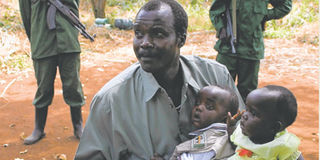Is Kony a terrorist, myth or just a misunderstood man?

Lord’s Resistance Army (LRA) leader Joseph Kony, holds his daughter, Lacot, and son, Opiyo in Ri-Kwangba, southern Sudan, in this November 30, 2008 file photo. The book The Lord’s Resistance Army: Myth and Reality offers varied accounts of why Kony may remain in the bush for a long time to come. Photo/FILE
The name Joseph Kony is easily mentioned in African Union, United Nations and state security meetings in the Great Lakes region in the same way Al Qaeda is talked about. Kony evokes anger, anxiety and terror.
For the global security and human rights fraternity, Kony is a terrorist. For the media he is the enigma whose shadow is chased in the bushes of Uganda, Sudan, the Democratic Republic of Congo or the Central African Republic.
Should the mirage prove elusive, the easy thing to do is ‘google’ him and produce copy with the damndest adjectives. But like the irritating stain on a white shirt, Kony remains. Why?
Many explanations have been offered about why Kony survives and continues to terrorise citizens of the countries that he crisscrosses throughout the year.
Eleven chapters
But The Lord’s Resistance Army: Myth and Reality edited by Tim Allen and Koen Vlassenroot (Zed Books, 2010) offers the most recent, comprehensive and varied accounts of why Kony may remain in the bush for a long time to come.
The contributors to the 11 chapters in the anthology include a journalist, a cultural activist, researchers on development, peace, justice, a historian, an aid worker, among others; all who have an interest in the question of peace in Northern Uganda.
As one would expect, the text details the origins of the LRA in Alice Lakwena’s spiritual movement, the vanquishing of the Ugandan army by Museveni’s National Resistance Army (NRA), the subsequent state ‘treatment’ of the northern Ugandan’s, especially the Acholi, as a defeated people manifested in harassment by state officials and the army and economic marginalisation of the region, the general state of wars in the surrounding countries, among other factors.
In a sense, Kony’s rebellion is a consequence of many factors, some actually dating from the colonial era. Thus, although Kony may be a villain in the eyes of the international community, there is no doubt that his agents have committed atrocities in the name of fighting the Ugandan government.
The jury is out on Kony. But probably this is the problem with him. That amidst the universal condemnation is lost the possibility of working towards peace in Uganda. Those who write and speak about Uganda seem to conveniently forget that for as long as Northern Uganda is in a state of war then the rest of Uganda is actually a war-torn country.
Those ‘spots’ of war out there in the bush can easily become the catalyst for another uprising in Uganda, especially now that the NRM government seems hell-bent on maintaining its grip on power. If one added in the mix the ‘politics of oil’ then Uganda may have on its hands more than just one ‘shadowy’ figure and a band of bandits to content with.
It is revealing to read in The Lord’s Resistance Army: Myth and Reality a statement attributed to the Ugandan government that the NRA does not have the capacity to beat an army of just about 2,000 fighters, many who only have rudimentary military skills but are seasoned guerrilla fighters.
But also, as Andrew Mwenda, a reputable Ugandan journalist argues, the war in the North has been used by the Kampala regime as a reason (really an excuse), to among other things, expand its defence budget (with the naturally consequent corruption related to tendering for military goods and services), and also to rule “the north as if it were a colonial territory.”
Indeed many civil wars continue to be waged all over the world simply because states that cannot realistically win a military war resort to ‘colonising’ the civilian population. Resentment may not be experienced publicly but it ferments and festers in those internally displaced camps, deserted homes or pathways.
The likes of Kony seemingly understand that they will never receive public support from the majority of suffering Acholi, Lang’o and Teso who suffer when he visits. But he knows that neither is Museveni and his soldiers ‘saviours’ to these same communities.
The Lord’s Resistance Army: Myth and Reality does not seem to suggest any realistic resolution to the conflict. But can one even guarantee that with Kony killed or jailed there won’t be a new rebel leader if the Ugandan state continues to behave belligerently in the north?
The international community should also commit adequate resources to capturing and trying Kony or to a viable resolution of the conflict rather than issuing UN resolutions which cannot be enforced.
The writer teaches literature at the University of Nairobi




